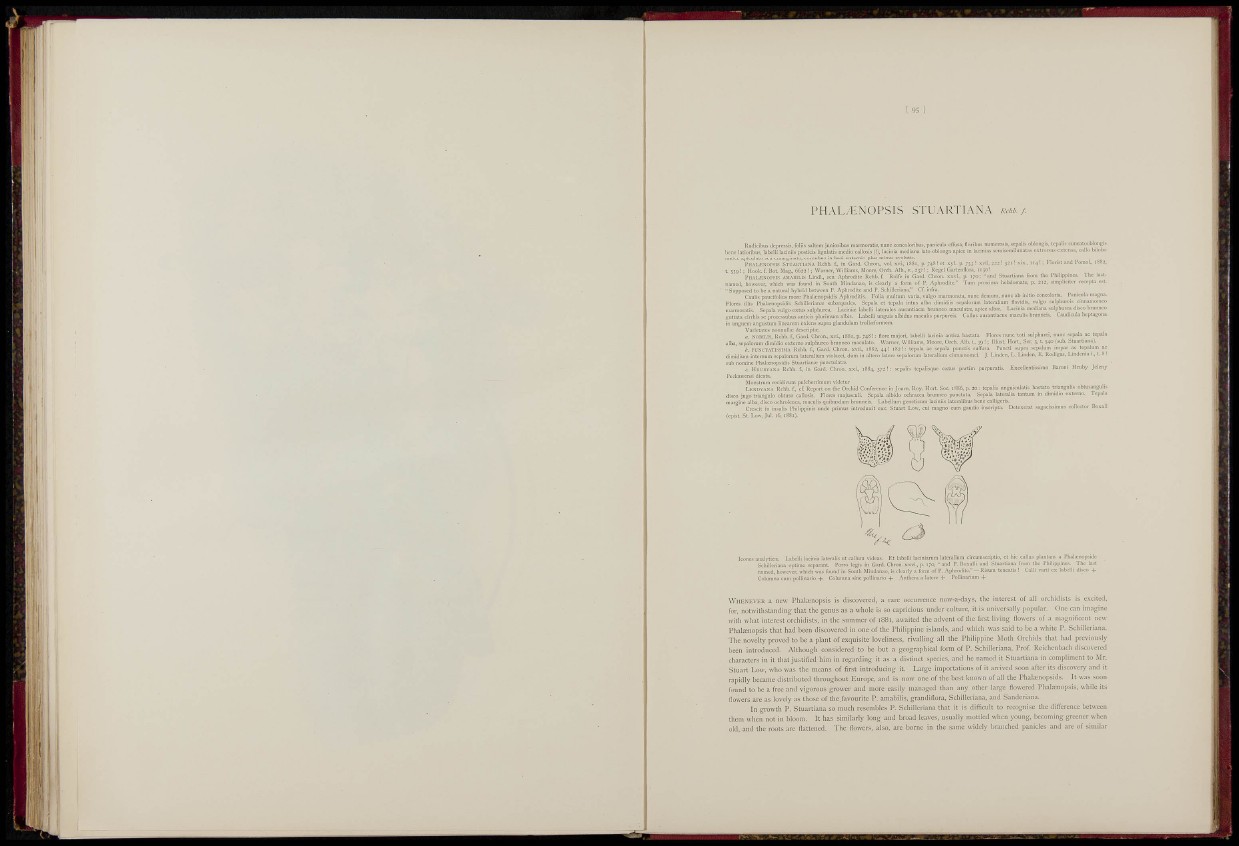
if
.1; I :
I ' H A L / E N Ü I ' S I S STUARTIANA rm./.
as dcpressis, foliis s.i
:is liRiilatis medio callosis (I), I
I'llAl.iiNOPSts Stuaktiana Rclib. f., in Gnid. Cliroii., vol. xvi,, 1881, ¡i. 7.18 let xyl. p. 7S3 ! x
I. 5391 ; Hook. r. 1(01. Mag., 6622 ! ; Warner, Williams, Moore, Orch. Alb., v., 237 ! : R^gcl Garteiinora, 11
I'UAL.BXOI'SIS AMAülLIS Lindl., seu Aphrodil« Rclib. f. Rolfe in Gaid. Cliroii. xxvi., p. 170:
named, however, \>hieh was found in South Mindanao, is clearly a form of i'. Aphrodile." Tiim pr
" Supposed to be a naturai hybrid between I'. Aplirodite and I'. Schillcriana." Cf infra.
Gaulis paiicifoliuä more I'halajnopsidis Aphrodtüs. Foli» multum varia, vulgo inarniorala, nunc d
fiores illis Phala.-nopsidis Schillcriana; subsquales. Scpala et tupaia intus alba dimidiis «palorum
niarmoraüs. Sq>ala vulgo cxtus sulphurea. Lacinia; label Ii late '
gullata eirrhis so proccssubus anticis plurimum albis. Labelli unj
sepalis nblongi«, topalis cuneairxiblonKi»
n flavidis, vulgo tulphurcis c
Lacinia mediana sulphurea disco Drunneo
s niaculis brunneis. Caudieula heplagona
ata. Flore.» nunc totl íulphurci, nunc scpala ae tciwla
i„ 39 ! ; Illust. Moi^, Ser. 3,1. 540 (sub. Stuartiana).
suffusa. l'uncti »upra scpalum impar ac tepalum ac
aei, J. Linden, L. Linden, E. Rodigas, I.indcnia i., t. « I
alba, sepalonini dimidio externo sulpliurco brunneo tumulato. Wamcr! Williams, Moore, Orcli. All
_ (>. ruNCTATISiiiMA Rchb. r, Card. Chrun. xvii., 1SS2. ! «l"'" P""':''
sub nomine Phalainopsidis Stuartiana: punelulata;.
c. HUUUYANA Rchb, f.. In Card. Chron. xxi., 1884, 373!: 5C|ialis lepalisquc exlus jjail'cekawenii
dicala.
Monslruin reeidivum piilchcrrimura videtur
Lendyaka Rchb. f., e f. Report on the Orchid Conference in Journ. Roy. Hort. Soe. 1886, |
disco jugo triangulo obtuso enllosis. Flores majusculi. Sépala nlbido ocliracea hnmneo puncmt
mainine alba, disco ochroleuca, maculis quibusdara bninncís. Labellum genelicum laeiniis latcralib
cdlenüsfimo Baroni Hruby Jeler.y
Crcscit in
. St. Low, Jul. 16, 1881),
(cpist
e. Stuart L
•0 I [epalis imgiiiculatis lia.stato triangulis obtusan
Scpala latcndia tantum in dimidio externo. Ti
bene calligcris,
Jio inscripta, Dctexerat sagacissimus collector lì
cs analytical, l-nbelli lacinia lateralis ut cai
Schillcriana optime scparant. Porro le^.- ... ,- , -,
named, however, which was found in South Mindnnao, is clearly ' A p h r o d i t e . " — Risi
W'HENiiVE« a new Plialicnopsis is discovered, a rare occurrence now-a-days, tlic interest of all orcliiclists is excited,
for, nolwithsfancling- tiiat the genus as a whole is so capricious under culture, it is universally popular. One can imagine
with what iiuerest orchidists. !ii the summer of 1881, awaited the advent of the first living Howcrs of a magnificent new
Phatenopsis that had been discovered in one of the Philippine islands, and which was-said to be a white P. Schillcriana,
The novelty proved to be a plant of exquisite loveliness, rivalling all the Philippine Moth Orchids that had previously
been introduced. Although considered to be but a geographical form of P. Schillcriana, Prof. Reichenbach <liscovercd
characters in it that justified him in regarding it as a distinct species, and he named it Stiiartiana in comjilimcnt lo .Mr,
Stuart Low, who \vas the means of first introducing it. Large importations of it arrived soon after its discovery and it
rapidly became distributed throughout Europe, and is now one of the best known of all the Phalainopsids. It was soon
found to be a free and vigorous grower and more easily managed than any othei- laqje flowered Phatenopsis, while its
llowers are as lovely as those of the.favourite P. amabilis, grandiflora, Schillcriana, and Sanderiana.
In growth P. Stuartiana so much resembles P. Schillcriana that it is difficult to recognise the difference between
them when not in bloom. It has similarly long and broad leaves, usually mottled when young, becoming greener when
old, and the roots are flattened. The flowers, also, are borne in the same widely branched panicles and are of similar